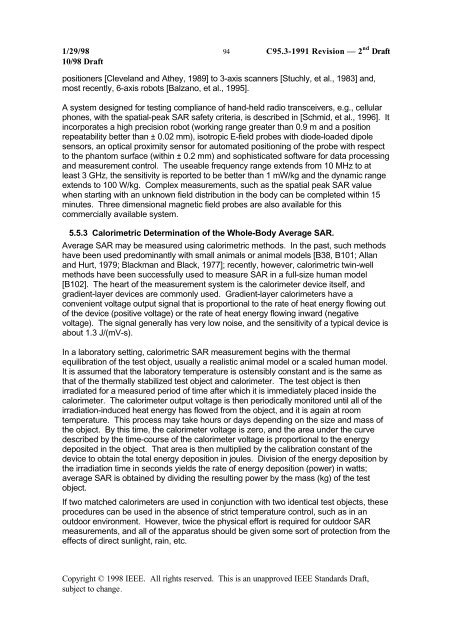DRAFT Recommended Practice for Measurements and ...
DRAFT Recommended Practice for Measurements and ...
DRAFT Recommended Practice for Measurements and ...
Create successful ePaper yourself
Turn your PDF publications into a flip-book with our unique Google optimized e-Paper software.
1/29/98 94 C95.3-1991 Revision — 2 nd Draft<br />
10/98 Draft<br />
positioners [Clevel<strong>and</strong> <strong>and</strong> Athey, 1989] to 3-axis scanners [Stuchly, et al., 1983] <strong>and</strong>,<br />
most recently, 6-axis robots [Balzano, et al., 1995].<br />
A system designed <strong>for</strong> testing compliance of h<strong>and</strong>-held radio transceivers, e.g., cellular<br />
phones, with the spatial-peak SAR safety criteria, is described in [Schmid, et al., 1996]. It<br />
incorporates a high precision robot (working range greater than 0.9 m <strong>and</strong> a position<br />
repeatability better than ± 0.02 mm), isotropic E-field probes with diode-loaded dipole<br />
sensors, an optical proximity sensor <strong>for</strong> automated positioning of the probe with respect<br />
to the phantom surface (within ± 0.2 mm) <strong>and</strong> sophisticated software <strong>for</strong> data processing<br />
<strong>and</strong> measurement control. The useable frequency range extends from 10 MHz to at<br />
least 3 GHz, the sensitivity is reported to be better than 1 mW/kg <strong>and</strong> the dynamic range<br />
extends to 100 W/kg. Complex measurements, such as the spatial peak SAR value<br />
when starting with an unknown field distribution in the body can be completed within 15<br />
minutes. Three dimensional magnetic field probes are also available <strong>for</strong> this<br />
commercially available system.<br />
5.5.3 Calorimetric Determination of the Whole-Body Average SAR.<br />
Average SAR may be measured using calorimetric methods. In the past, such methods<br />
have been used predominantly with small animals or animal models [B38, B101; Allan<br />
<strong>and</strong> Hurt, 1979; Blackman <strong>and</strong> Black, 1977]; recently, however, calorimetric twin-well<br />
methods have been successfully used to measure SAR in a full-size human model<br />
[B102]. The heart of the measurement system is the calorimeter device itself, <strong>and</strong><br />
gradient-layer devices are commonly used. Gradient-layer calorimeters have a<br />
convenient voltage output signal that is proportional to the rate of heat energy flowing out<br />
of the device (positive voltage) or the rate of heat energy flowing inward (negative<br />
voltage). The signal generally has very low noise, <strong>and</strong> the sensitivity of a typical device is<br />
about 1.3 J/(mV-s).<br />
In a laboratory setting, calorimetric SAR measurement begins with the thermal<br />
equilibration of the test object, usually a realistic animal model or a scaled human model.<br />
It is assumed that the laboratory temperature is ostensibly constant <strong>and</strong> is the same as<br />
that of the thermally stabilized test object <strong>and</strong> calorimeter. The test object is then<br />
irradiated <strong>for</strong> a measured period of time after which it is immediately placed inside the<br />
calorimeter. The calorimeter output voltage is then periodically monitored until all of the<br />
irradiation-induced heat energy has flowed from the object, <strong>and</strong> it is again at room<br />
temperature. This process may take hours or days depending on the size <strong>and</strong> mass of<br />
the object. By this time, the calorimeter voltage is zero, <strong>and</strong> the area under the curve<br />
described by the time-course of the calorimeter voltage is proportional to the energy<br />
deposited in the object. That area is then multiplied by the calibration constant of the<br />
device to obtain the total energy deposition in joules. Division of the energy deposition by<br />
the irradiation time in seconds yields the rate of energy deposition (power) in watts;<br />
average SAR is obtained by dividing the resulting power by the mass (kg) of the test<br />
object.<br />
If two matched calorimeters are used in conjunction with two identical test objects, these<br />
procedures can be used in the absence of strict temperature control, such as in an<br />
outdoor environment. However, twice the physical ef<strong>for</strong>t is required <strong>for</strong> outdoor SAR<br />
measurements, <strong>and</strong> all of the apparatus should be given some sort of protection from the<br />
effects of direct sunlight, rain, etc.<br />
Copyright © 1998 IEEE. All rights reserved. This is an unapproved IEEE St<strong>and</strong>ards Draft,<br />
subject to change.
















